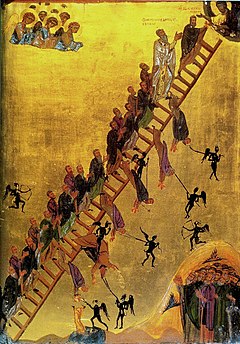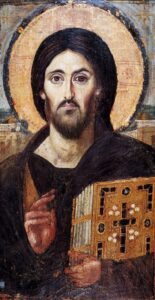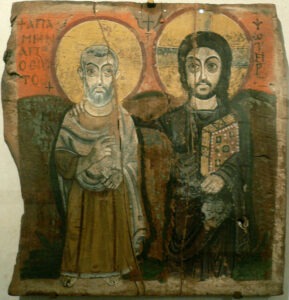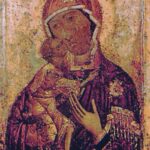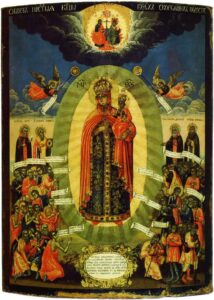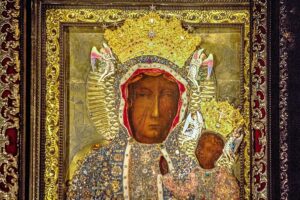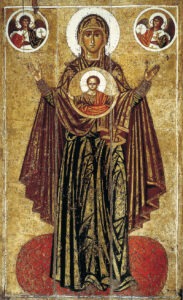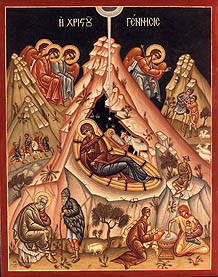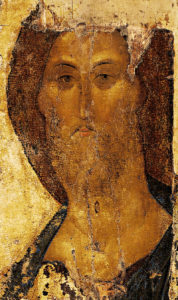The Ladder of Divine Ascent resides in Saint Catherine’s Monastery, Mount Sinai. The original was based on a treatise by Saint John Climacus and was painted in the 12th century. The icon depicts a ladder to heaven, with Jesus at the top and monks climbing with demons attacking or pulling them from the ladder. It is an allegory of the Christian life.
Christ Pantocrator is the term for a specific form of picture of Christ. “Pantocrator” means almighty, or all-powerful. In the Western world, it’s more often called “Christ in Majesty.” Most Orthodox and Catholic churches have one of these icons prominently placed, and they also can be found in the homes of many. The most famous of these is the mosaic that is in Hagia Sophia, Istanbul.
Christ Pantocrator, encaustic on panel, is the oldest known icon of this category. From the 6th century, this icon resides in Saint Catherine’s Monastery.
The Trinity, painted by Andrei Rublev, is also known as The Hospitality of Abraham. Painted in the 15th century, this icon is Rublev’s most famous work. While it is a depiction of the angels visiting Abraham, it is also interpreted as a reference to the Trinity – Father, Son, and Holy Spirit – with the understanding that the three angels each represented one aspect of the Godhead.
It is not clear when the Theotokos of Vladimir was first painted; however, it is said it was kept in Jerusalem until around 450AD, at which point it was taken to Constantinople. It is known as “of Vladimir” because that is where Prince Andrew placed it, after stealing it from his father. It currently resides in Moscow, Russia.
Saint Arethas is a rare ceramic icon, from the 10th century. Arethas was a martyr of the first century. It is currently at Walters Art Museum in Baltimore, Maryland.
Image of the Saviour Not Made by Hand (also called Acheiropoieta, which means “made without hand”) and is believed to have been an image transferred to cloth from being pressed against Jesus’ face. There are actually more than one of these; the most famed one is likely the Shroud of Turin which is kept in the Cathedral of Saint John the Baptist in Turin, Italy.
Christ and Abbot Saint Menas, painted on wood around the 6th century, is a Coptic painting. Brought from Egypt, the icon is now in the Louvre museum in Paris, France.
The image of the Archangel Gabriel, an icon of Novgorod, was painted with egg tempura in the 12th century. It currently resides in the Russian Museum in St. Petersburg.
St Peter, an encaustic painting on a panel, was made around the 6th century. It resides in St. Catherine’s Monastery in Sinai, Egypt.
Our Lady of St Theodore, also known as the “Black Virgin of Russia,” was created in the 11th century. It was copied by in 1703. It is currently encased in a chasuble in Epiphany Cathedral in Kostroma.
Bogorodica Trojeručica (which means “three-handed Theotokus”) is a Serbian icon that resides in the Serbian Orthodox monastery in Greece. It shows Mary and Jesus. Tradition says that John of Damascus was accused of treachery, but falsely, and had his hand cut off as punishment. It further says that, while he prayed in front of an icon of the Theotokos, his hand was miraculously restored. In reference to this alleged miracle, he had a replica of his hand made of silver and attached to the icon, which is why it is known as “three-handed.”
Joy of All Who Sorrow is the name used for icons of the Theotokos standing below Jesus, who is in Heaven as king, with people and angels surrounding her. One of the most well known of these is the one that is in the Chapel of Saint Sergius of Radonezh, in New York City. It is believed to have renewed itself miraculously during and after the Russian Revolution, and the Civil War.
The Black Madonna of Czestochowa, Poland, resides in the Jasna Góra Monastery. It is believed to have originated around the 14th century, though some believe it was originally painted in the home of the Holy Family, while Mary posed. Three different Popes have recognized the icon, in 1717, 1910, and 2005.
The Icon of the Crucifixion, from about 1360, is housed in the Louvre in Paris. This icon, like many Russian icons, was copied and recopied and the original artist is not as well known as some others. This in no way takes away from the beauty or value of the icons, however.
Panagia refers to an icon in which the Theotokos is facing the viewer, often with hands in the “orans” position, which has elbows near her sides and hands outstretched. The Great Panagia is from the 13th century, probably Yaroslavl, Russia.
The Nativity of Christ, by Andrei Rublev, is from the 15th century. This icon contains a large quantity of symbolism, beginning with Jesus at the center with His mother, who are in a cave with animals that are watching Him. The manger is similar to a casket, and the swaddling clothes are graveclothes. The star, magi, shepherds, and the gifts are also represented, and the angels, glorifying God, are above. The icon is housed at the Cathedral of the Annunciation in Moscow.
Christ the Redeemer, also by Andrei Rublev, depicts Jesus Christ, full face to the viewer. Kept in the Tretyakov Gallery in Moscow, this icon is from about 1410. It was discovered accidentally near Zvenigorod in 1919.
While there are many more icons, especially when considering that different icons are recognized by different denominations, these are some of the icons that are most universally recognized, or most famous throughout the Orthodox and Catholic circles. Each of these has a variety of copies, alternate works, and interpretations, and many have been made in multiple media. Regardless of the artist, media, or origin, however, all of them are used for the same purpose: to point believers to the Saviour Jesus Christ.

